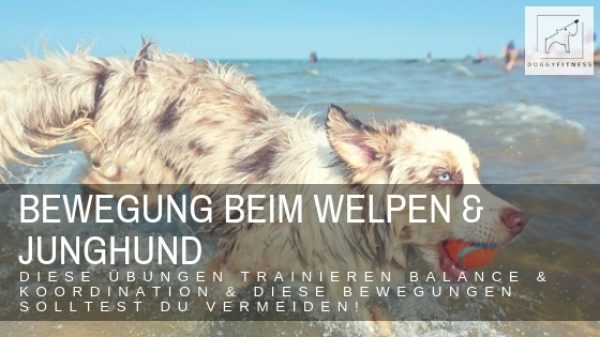The last article was already about how much a puppy or young dog may and should be moved. In this article, I want to give you suggestions and ideas on how to specifically move your puppy or young dog to train their body awareness, balance and coordination. Furthermore, you will also learn which movements are actually harmful for him.
Targeted exercise for puppies and young dogs is useful to strengthen their musculoskeletal system and promote healthy movement. At the same time, they are a great way to keep the young dog meaningfully occupied and also strengthen the bond with the dog. I present some suggestions here:
Running over various uneven surfaces
This specifically promotes proprioception, which means the perception of one’s own body in space. But coordination and balance are also trained. No special equipment is needed for this. For example, you can use various surfaces that are available on the walk, such as sand, a plowed field, a forest floor full of roots, etc., over which you lead the young dog.
But also an air mattress with little air in it can be used so that the young dog runs over it and balances. But also pebbles or a bubble wrap over which the dog runs are super suitable to strengthen the feeling for the own body.
More ideas for exercise for puppies
In addition, branches are suitable to climb over, tree stumps to go around them or a sand hill to climb. In the garden, a paddling pool filled with balls is also huge fun.
There are no limits to your own imagination. However, you should always pay attention to the safety of the dog. Give your dog sufficient guidance and please secure him on a harness and leash. Again, please take it slow and introduce your young dog to new exercises step by step. In the beginning, 1-2 exercises are quite enough. Gradually, you can then add new exercises. The exercise sessions should be short, as they require a high level of concentration, even if it looks so playful. Start with about 30 seconds and increase the units very slowly.
These movements should be avoided in the puppy and young dog
There are movements that tend to harm the joints of a puppy and young dog. Therefore, you should try to avoid them:
These movements should be avoided in the puppy:
- Ball and tug games and games with a stick
- Racing and catching games
- jumping over obstacles (even if they are only low)
During these movements there is an increased thrust of the hindquarters and simultaneous braking with the forequarters. This results in a very heavy load on the front legs.
Catching Frisbees, or balls from a jump is also taboo. If you look at these movements, you can see that there is an enormous physical strain here. In addition to the already intense stress caused by braking and landing, there is also a turning of the body in the air. Massive shear forces are generated here, which act on the joints. Studies have shown that during movements of this type, depending on the speed, gait of the dog and body weight, between 700-1000% of the dog’s body weight acts on its joints.
There are also these important points to consider when moving the puppy and young dog:
- Bicycling and jogging are only allowed from the age of 12 months at the earliest! Again and again you see young dogs running next to the bike. This is not healthy. Be happy to familiarize your dog with the bike itself and also let him walk alongside when you are pushing the bike. But active running on the wheel is not healthy until the end of growth!
- After a long walk the puppy should not romp with other dogs. The risk of injury from exhaustion is significantly increased. Reason should be applied here.
- Playing too wildly is also not good. Right, the dog should play and make his experiences. However, if things get too wild and rough, it is your responsibility to stop the game. Otherwise, severe bruises and joint injuries are the possible result.
Can my puppy or young dog climb stairs?
This is a vexed and much discussed topic. In principle, he is allowed to do so. And in a controlled and healthy way! This allows the puppy or young dog to walk up a flight of stairs in a controlled manner on a leash. This also helps him become familiar with the movements and perform them safely. There is little point in acclimating a dog to stairs until it is 9 months old. He will then be much more insecure about these movements than if you had practiced it with him to a healthy degree while he was still a puppy. However, if many steps have to be mastered several times a day, you should then carry the dog.
When a puppy or young dog shows suspicious symptoms
If the puppy or young dog suddenly moves stiff-legged, avoids normal movements or even limps, this should be taken seriously in any case. Then I highly recommend taking the dog to your veterinarian for further testing.
Conclusion: Exercise in puppy and young dog
Basically, you should use common sense when moving a young dog. Neither too much nor too little exercise is beneficial to health. Don’t pack your dog in absorbent cotton, but don’t overdo it either. After all, you want to spend as long as possible with your four-legged companion by your side!
Exercises Puppies Exercises Puppies Exercises Puppies Exercises Puppies
Dieser Beitrag ist auch verfügbar auf:
Français (French)
Deutsch (German)
Español (Spanish)
















